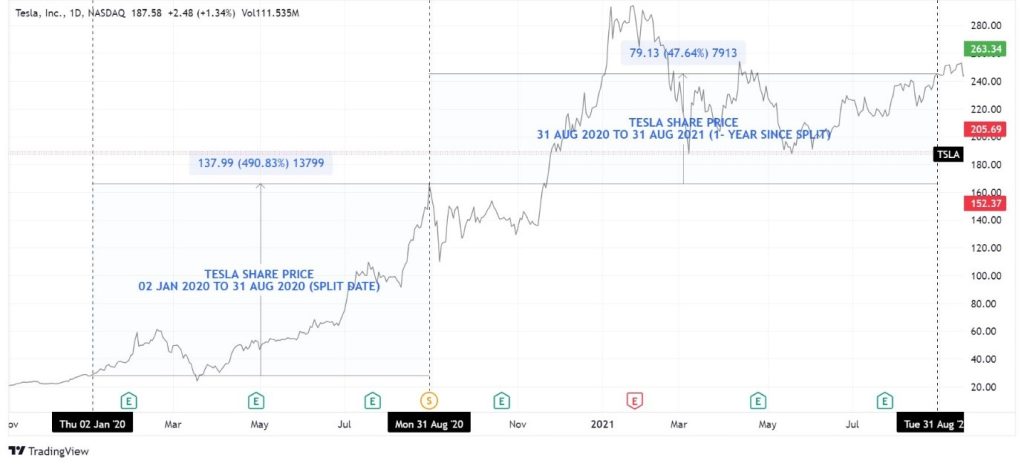
Stock splits and share consolidations are corporate actions undertaken by companies to adjust the number of shares outstanding in the market, affecting their respective prices. Various factors drive these actions and can have significant implications for the company and its investors.
Stock Splits
A stock split involves dividing each existing share into multiple shares, effectively increasing the number of shares outstanding while proportionally reducing the price per share. The split ratio determines the number of new shares issued for each existing share.
Companies implement stock splits for several reasons. Firstly, it aims to make shares more affordable for retail investors, thereby increasing liquidity and broadening ownership. Secondly, it can enhance marketability and trading activity by attracting new investors. Stock splits often occur when share prices rise significantly, making individual shares too expensive for small investors to afford. Despite debates, historical evidence suggests stock splits may drive short-term outperformance. This is likely due to pre-split momentum from price gains or investor interest.
Walmart Inc (NYSE: WMT) announced its first stock split since 1999, at a ratio of 3:1. The big box retailer states that the stock split aims to motivate employees to invest in company shares by boosting employee participation in the stock purchase plan. With over 400,000 employees enrolled, effective 26 February, the split will increase outstanding shares from 2.7 million to 8.1 million. Walmart could anticipate increased employee buying post-split, potentially boosting its stock price.
One prominent example is Tesla Inc’s (NASDAQ: TSLA) two stock splits in recent years. In August 2020, Tesla implemented a 5:1 stock split to make its shares more accessible to employees and investors, following a surge in its share price by 490% from January 2020 to the date of the split in August. The share price subsequently surged by 48% a year later, as upward momentum was sustained post-split.

Subsequently, in August 2022, Tesla underwent a 3:1 stock split to diversify its investor base and attract retail investors. However, despite the initial positive sentiment, Tesla’s share price performance post-split varied, indicating mixed outcomes for investors. Despite emulating tech giants like Amazon, the move led to a 20% post-split decline a year later, driven by macroeconomic hurdles, including soaring inflation and Federal Reserve rate hikes, which dampened consumer spending on big-ticket items like electric vehicles.
Stock splits offer advantages for companies and investors, increasing liquidity, attracting more investors, and lowering the price per share for potential investors. However, they may signal management concerns and involve administrative complexities. Importantly, while they adjust share prices and outstanding shares, they don’t change a company’s intrinsic value.
Share Consolidation
Conversely, share consolidation involves reducing the number of outstanding shares by combining multiple existing shares into one share, thereby increasing the share price proportionally. Share consolidations are typically undertaken to boost the perceived value of shares and attract institutional investors.
One notable example is Richemont’s (JSE: CFR) share consolidation in April 2023, which aimed to list its shares on the JSE and replace depositary receipts. As part of its secondary listing on the JSE, Richemont consolidated its shares at a ratio of 1:10. This consolidation increased the share price and aligned it with the company’s primary listing on the SIX Swiss Exchange, thereby enhancing its market position and investor perception.
Share consolidations offer advantages such as boosting share prices, improving market perception, and attracting institutional investors. They also streamline administrative tasks and may enhance financial metrics. Yet, they could signal financial struggles or limited growth prospects, dissuading investors. Higher share prices post-consolidation might hinder retail investors’ participation, reducing liquidity.
Summary
In conclusion, stock splits and share consolidations are strategic corporate actions aimed at adjusting the number of shares outstanding and their respective prices. While these actions offer various benefits, they also present challenges and considerations for companies and investors alike. Understanding the motivations and implications of stock splits and share consolidations is crucial for making informed investment decisions.
Sources: Corporate Finance Institute, Nasdaq, Bloomberg, CNBC, Reuters, Company filings and announcements, TradingView
Piece Written By Nkosilathi Dube, Trive Financial Market Analyst
Disclaimer: Trive South Africa (Pty) Ltd (hereinafter referred to as “Trive SA”), with registration number 2005/011130/07, is an authorised Financial Services Provider in terms of the Financial Advisory and Intermediary Services Act, 37 of 2002. Trive SA is authorised and regulated by the South African Financial Sector Conduct Authority (FSCA) and holds FSP number 27231. Trive Financial Services Ltd (hereinafter referred to as “Trive MU”) holds an Investment Dealer (Full-Service Dealer, excluding Underwriting) Licence with licence number GB21026295 pursuant to section 29 of the Securities Act 2005, Rule 4 of the Securities Rules 2007, and the Financial Services Rules 2008. Trive MU is authorized and regulated by the Mauritius Financial Services Commission (FSC) and holds Global Business Licence number GB21026295 under Section 72(6) of the Financial Services Act. Trive SA and Trive MU are collectively known and referred to as “Trive Africa”.
Market and economic conditions are subject to sudden change which may have a material impact on the outcome of financial instruments and may not be suitable for all investors. Trive Africa and its employees assume no liability for any loss or damage (direct, indirect, consequential, or inconsequential) that may be suffered. Please consider the risks involved before you trade or invest. All trades on the Trive Africa platform are subject to the legal terms and conditions to which you agree to be bound. Brand Logos are owned by the respective companies and not by Trive Africa. The use of a company’s brand logo does not represent an endorsement of Trive Africa by the company, nor an endorsement of the company by Trive Africa, nor does it necessarily imply any contractual relationship. Images are for illustrative purposes only and past performance is not necessarily an indication of future performance. No services are offered to stateless persons, persons under the age of 18 years, persons and/or residents of sanctioned countries or any other jurisdiction where the distribution of leveraged instruments is prohibited, and citizens of any state or country where it may be against the law of that country to trade with a South African and/or Mauritius based company and/or where the services are not made available by Trive Africa to hold an account with us. In any case, above all, it is your responsibility to avoid contravening any legislation in the country from where you are at the time.
CFDs and other margin products are complex instruments and come with a high risk of losing money rapidly due to leverage. You should consider whether you understand how these products work and whether you can afford to take the high risk of losing your money. Professional clients can lose more than they deposit. See our full Risk Disclosure and Terms of Business for further details. Some or all of the services and products are not offered to citizens or residents of certain jurisdictions where international sanctions or local regulatory requirements restrict or prohibit them.




